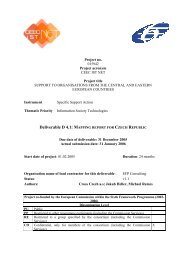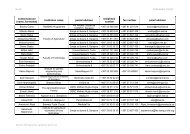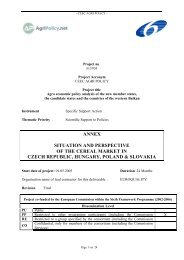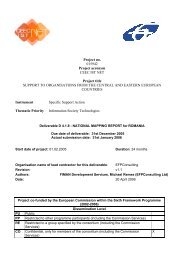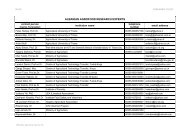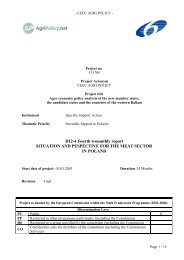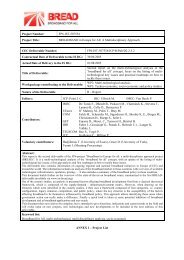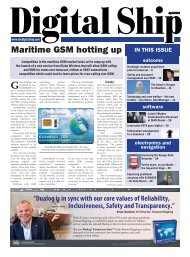Project Number: FP6-IST-507554 Project Title: BROADBAND in ...
Project Number: FP6-IST-507554 Project Title: BROADBAND in ...
Project Number: FP6-IST-507554 Project Title: BROADBAND in ...
You also want an ePaper? Increase the reach of your titles
YUMPU automatically turns print PDFs into web optimized ePapers that Google loves.
4. Introduction<br />
Page 12 of 319<br />
<strong>FP6</strong>-<strong>IST</strong>-<strong>507554</strong>/JCP/R/Pub/D2.2-3.2<br />
This report is the second deliverable of the <strong>FP6</strong>-project “Broadband <strong>in</strong> Europe for all: a multi-discipl<strong>in</strong>ary<br />
approach project (BREAD)”. It is a multi-technological analysis of the ‘broadband for all’ concept, with an<br />
update of the list<strong>in</strong>g of multi-technological key issues, a first gap analysis and first roadmaps on how to tackle<br />
these issues.<br />
This document builds further on the first BREAD-deliverable (available via www.ist-bread.org). This<br />
deliverable (D2.1-3.1) focused on the multi-technological and multi-discipl<strong>in</strong>ary analysis of the ‘broadband for<br />
all’ concept with emphasis, and restricted to the ‘state of the art’ <strong>in</strong> the multi-technological doma<strong>in</strong>s and ‘what’s<br />
happen<strong>in</strong>g now’ <strong>in</strong> some of the countries of importance to the broadband deployment. That first deliverable<br />
collected <strong>in</strong>formation on ongo<strong>in</strong>g regional and national <strong>in</strong>itiatives <strong>in</strong> Europe and around the world. In addition,<br />
the deliverable identified <strong>in</strong>itiatives, which the project team <strong>in</strong>tended to contact for further collaboration and<br />
exchange of ideas and <strong>in</strong>formation. The document also evoked new contacts which were fed <strong>in</strong>to the present<br />
deliverable.<br />
After some more general remarks concern<strong>in</strong>g the projects and organisations <strong>in</strong>volved <strong>in</strong> the “Broadband for<br />
All”-concept (section 5 on “Related projects and standardisation”) the convergence of services, networks,<br />
term<strong>in</strong>als and markets is discussed <strong>in</strong> section 6 on “ICT convergence”. The convergence of different<br />
technologies, platforms and access possibilities and how the overall ICT convergence trends will <strong>in</strong>fluence the<br />
broadband development is discussed with a view to the regulatory and market challenges implied by<br />
convergence.<br />
The BREAD project has now updated the <strong>in</strong>formation on all major technologies <strong>in</strong>volved, which were already<br />
identified <strong>in</strong> its first deliverable. This <strong>in</strong>formation is based on the contacts and <strong>in</strong>put from other sources (<strong>FP6</strong>projects,<br />
national projects, <strong>in</strong>ternational organisations,…) and is presented <strong>in</strong> section 7 on “Broadband<br />
technologies summary”. Some of these technologies need, to our op<strong>in</strong>ion, a closer look, because of their general<br />
importance (e.g. security,…) or because it is considered as a major technological solution (cable, FTTx,…).<br />
These areas are worked out <strong>in</strong> more detail and are presented <strong>in</strong> a separate section <strong>in</strong> “Annex 2 – More<br />
<strong>in</strong>formation”. For all areas discussed <strong>in</strong> section 7 on “Broadband technologies summary”, an overview is given<br />
of the (updated) “state-of-the-art” <strong>in</strong> that area, a short summary of the socio-economic issues, together with a<br />
list<strong>in</strong>g of projects and organisations <strong>in</strong>volved <strong>in</strong> this specific area. For all these areas also a first “gap analysis” is<br />
presented, together with a first “roadmap”. This deliverable also synthesises these multi-technological areas and<br />
identifies and derives a list of common issues that need further attention and <strong>in</strong>teraction (security, management<br />
& control, …).<br />
The relative importance of the various technical bottlenecks identified <strong>in</strong> the BREAD vision depends to a large<br />
extent on the evolution of actual usage patterns. The evolution of these patterns, <strong>in</strong> turn, is based on the available<br />
and emerg<strong>in</strong>g applications and technologies, underly<strong>in</strong>g social behaviour, and social and organisational practices<br />
that create communication and <strong>in</strong>formation process<strong>in</strong>g needs. Social, economic and technical forces are<br />
<strong>in</strong>terdependent and create a complex field of development where technological opportunities become articulated<br />
and implemented, first <strong>in</strong> the laboratory or <strong>in</strong> field trials, and then on a societal scale. Only at that po<strong>in</strong>t of wide<br />
societal use, new technologies become "real" <strong>in</strong> the broader economic and societal sense. Accurate localisation<br />
of the critical bottlenecks of the BREAD vision as well as its effective realisation will therefore require a good<br />
understand<strong>in</strong>g of the socio-economic and technological drivers of the alternative developmental paths.<br />
Benchmark<strong>in</strong>g and comparative analyses of broadband development practices and schemes <strong>in</strong> an <strong>in</strong>ternational<br />
context are also an important study item, to identify current and future roadblocks.<br />
This multi-discipl<strong>in</strong>ary aspect of the “Broadband for all”-concept becomes clear <strong>in</strong> section 8 on "Market<br />
developments & policy aspects”. In this section, all EU25 and some other <strong>in</strong>terest<strong>in</strong>g non-EU countries are<br />
be<strong>in</strong>g studied. This section conta<strong>in</strong>s a general description of the market developments with<strong>in</strong> electronic<br />
communication networks <strong>in</strong> particular broadband networks. Furthermore general regulatory aspects and the<br />
implications of these are described. In addition a number of country cases are <strong>in</strong>cluded. The purpose of these<br />
country cases is to provide <strong>in</strong>sights both <strong>in</strong> regional success stories and failures and to enable a further analysis<br />
of the reasons for why some countries have been more successful than others. This <strong>in</strong>cludes identification of<br />
drivers, barriers, bottlenecks and technologies impact<strong>in</strong>g the penetration of broadband.<br />
An analysis is presented with factors affect<strong>in</strong>g broadband development first from a classical theoretical<br />
framework, which is composed of the supply/demand - <strong>in</strong>frastructure/content matrix. However, when draw<strong>in</strong>g<br />
on the elements which were identified <strong>in</strong> the country studies, it then uses a framework composed of four<br />
categories, i.e. country configuration, legacy situation, competition, and public policy, where the key criterion is<br />
the susceptibility of the factors affect<strong>in</strong>g broadband to be themselves <strong>in</strong>fluenced by broadband policy. This



